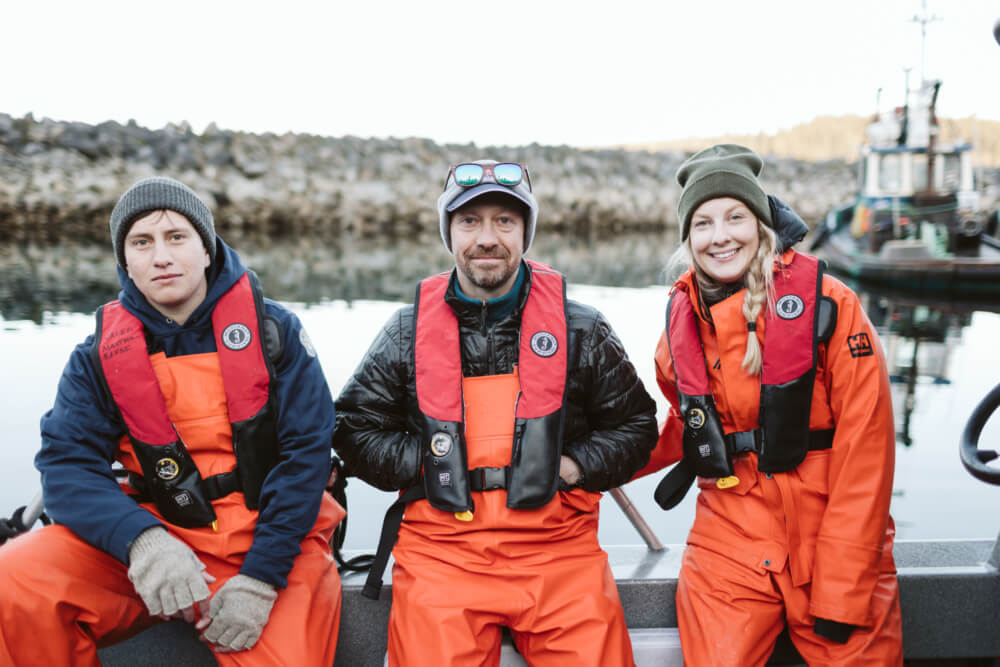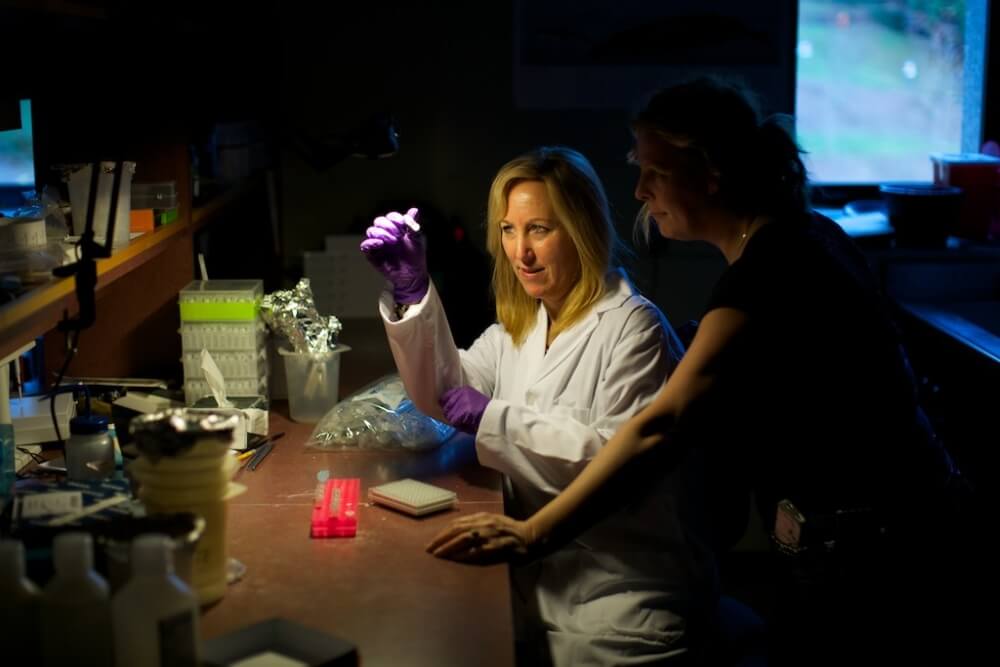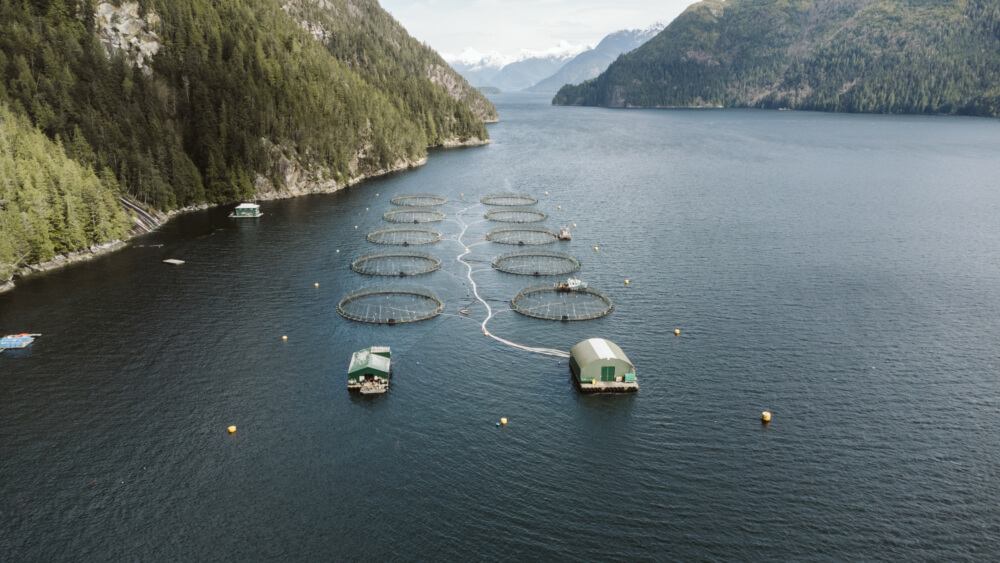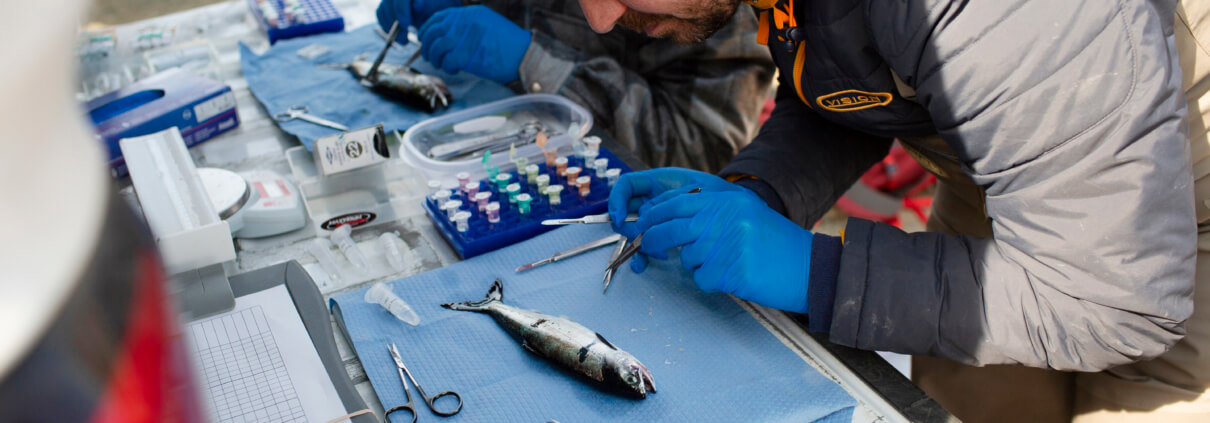Salmon Health — PSF and the DFO research team
One of our core values at the Pacific Salmon Foundation (PSF) is that we never go it alone. We work with partners — People for Salmon — across B.C. and the Yukon who share our passion and resolve to save and restore wild Pacific salmon.
One of our long-time partners at Fisheries and Oceans Canada (DFO), Dr. Kristi Miller-Saunders, leads a team of researchers in the Molecular Genetics Laboratory at the Pacific Biological Station in Nanaimo, B.C. The lab’s current research focuses on infectious disease and environmental stress in salmon and shellfish, population genomics, and environmental DNA applications for ecosystem monitoring.
“Kristi and her team have been instrumental in advancing our understanding of how pathogens impact wild Pacific salmon,” says Dr. Andrew Bateman, Manager of PSF’s Salmon Health program. “Using absolutely cutting-edge genetic tools, similar to those only now being applied in the field of human health, the lab can draw conclusions about health, stress, and disease in salmon that we could have only dreamt of a couple decades ago.”
Strategic Salmon Health Initiative–Salmon Health
Miller-Saunders was a driving force behind the Strategic Salmon Health Initiative (SSHI), developed through a partnership between DFO, the Pacific Salmon Foundation, and Genome BC. The program was the first of its kind to integrate large-scale studies on wild, hatchery, and farmed salmon.
Now, the Salmon Health program, which has evolved out of the SSHI, applies a multidisciplinary approach to screen for pathogens and environmental stress in B.C. salmon, and – critically – to understand the implications for persistence and rebuilding of wild salmon. The program also continues to conduct research to shed light on which pathogens may pose a risk of exchange between farmed and wild salmon, with a strong new focus on environmental DNA monitoring of pathogen spillover from farms, applied both in Canada and Norway.

(photo left to right: Kaleb Mantha-Rensi, Emiliano Di Cicco, and Kayla Zielke . photo credit: Brandon Deepwell)
In addition to Miller-Saunders, the research team includes Arash Akbarzadeh (DFO), Jonathan Archambault (PSF), Art Bass (University of British Columbia–UBC), Andrew Bateman (PSF), Christoph Deeg (UBC), Emiliano Di Cicco (PSF), Karia H Kaukinen (DFO), Shaorong Li (DFO), Kaleb Mantha-Rensi (PSF), Tobi J Ming (DFO), Gideon Mordecai (PSF/UBC), Angela D Schulze (DFO), Amy Teffer (University Massachusetts, Amherst), and Kayla Zielke (PSF).
Collectively, these dedicated researchers help comprise PSF’s #PeopleForSalmon.

(photo from left to right: Dr. Kristi Miller-Saunders, DFO and Nik West, BATI)
An interview with DFO’s Dr. Kristi Miller-Saunders
Can you tell us about your research?
For over 15 years, my program has focused on understanding the factors contributing to salmon declines. Since 2012, we directed our attention to infectious health, but now we are broadening our scope again to address cumulative factors, such as environmental stress and disease. This is made possible due to new technological innovations developed in my lab over this past 10 years to recognize specific stressor responses in salmon.
The approaches we have developed and applied to salmon are closely aligned to those developed in personalized human medicine, but in some ways, we have surpassed what is currently available for humans. Have you ever gone to your doctor and asked to be tested for all viruses, bacteria, and parasites that might be ailing you? Well we can do that now for most pathogens in salmon. And as we know that the environments salmon live in are becoming more stressful, and opportunistic diseases are often triggered by stress, we built tools to recognize different kinds of stress, and even the likelihood that a fish is dying. These tools, collectively called “Salmon Fit-Chips” use non-lethal gill clips, and can tell us when and where fish are most compromised, and likely to die, and which aspects of stress and disease are more likely associated with population-level impacts on survival.
If we know where salmon are experiencing stress, we can then apply environmental DNA, which captures the genetic material from cellular debris of all species co-existing in an ecosystem and determine the community composition of species co-habiting areas where salmon are most and least healthy — including species that are prey, predators, and competitors of salmon. These species compositions can provide targets to measure the effectiveness of habitat remediation efforts.
How long have you been working with the Pacific Salmon Foundation?
I have been working with Pacific Salmon Foundation since about 2013, when we put our heads together to ask, how could genomic technology bring some clarity on the role of infectious disease in declining salmon populations?
To answer this question, we decided to put the research program together with a partner outside of DFO, a partner like the Pacific Salmon Foundation, that could ensure that there was an external watchdog on the science. PSF serves as an unbiased group reviewing the data, interpreting the data, and communicating the data.
What role has the Pacific Salmon Foundation played in the program’s success?
The Pacific Salmon Foundation played an absolutely critical role in making sure that the science was not only done, but that it was heard, and that regulators, managers, and the general public knew what we were finding, and could interpret what we were finding for themselves.
Is there a relationship between fish-farms and salmon health? If so, what is it?
First, it is important to note that not all agents associated with population-level impacts on survival come from farms; some are naturally occurring agents that have become more impactful due to climate change. And with rising temperatures, we expect increases in the severity and frequency of some infectious diseases. That said, some of the agents that are the most predictive of survival in wild salmon are associated with spillover effects from farmed fish. At least one impactful agent, the bacterium Tenacibaculum maritimum, poses a higher risk both with farm exposure and elevated temperature. This is one we need to carefully control.

(photo of fish farm operation in the Broughton Archipelago of B.C. photo credit: Brandon Deepwell)
But what we can do about those that are at higher risk due to farmed-wild fish interactions?
We need to minimize the risk of exposure of our wild salmon to those pathogens. Of perhaps greatest concern are wild salmon that spend up to their first year of marine life rearing in Sounds where high-density salmon farms occur. These farms are allowed, by law, to be placed within 1 km of a salmon-bearing stream, which means there is essentially no protection from pathogen spillover effects for even the smallest, most vulnerable salmon — smolt outmigrants. For this reason, we have expanded our efforts to studying stress and disease risks to Chinook salmon in the Sounds off the West Coast of Vancouver Island to inform regulatory decisions in this critical region of the B.C. coast.
How has technology aided your research discoveries?
Innovative technology is allowing us to ask questions that were always considered too difficult to answer, especially in a field setting. We can bring salmon into a lab and determine if they are susceptible to a pathogen, or at what level of stress exposure they are likely to die, but it is difficult to know how important any given stress or pathogen is to wild salmon in their natural environment.
In the ocean, we assume that free-ranging salmon may be able to avoid stressful conditions. As predators quickly pick off fish that are compromised, the probability of sampling fish in a late stage of disease is low, so we need the most sensitive tools to recognize infection, stress, and disease. That is where the great inroads in human medicine come into play.
My lab has always closely followed advances in human medicine, and I have often gone to human medical conferences, I assure you as the only salmon researcher, to get ideas for highly sensitive methodologies that will work for salmon. In human medicine, non-lethal sampling is important (!), so we have tried, where possible, to base our innovations on non-lethal samples so they can be applied even in stocks and species of high conservation concern.
Our most recent application of salmon Fit-Chips will offer the first technology to understand cumulative stressors, not just infective stress, but how salmon are affected by changes to their environment, both due to climate change, but also due to other stressors.
Could you provide an example of how the “Fit Chip” is helpful?
An example is heat stress. Our biomarkers predictive of salmon experiencing heat stress can actually gauge how strong that heat stress is — they will activate more powerfully at 18oC than 14oC. Importantly, we find that thermal stress is the most common stressor in sockeye salmon migrating from the Fraser River up towards Alaska. In fact, up to 80% of fish sampled in the Strait of Georgia can show an indication of thermal stress, despite the fact that these fish could move to cooler waters at depth.
Importantly, the proportion of fish feeling thermal stress has risen over the past 10 years.
We also have biomarkers for salinity adaptation and stress. This biomarker panel tells us if our smolts are ready to enter the marine environment or if returning adults are ready to enter freshwater. And they tell us if salmon are feeling stressed by the salinity they are sampled in. These same biomarkers can also identify stress from other sources that creates an imbalance in the salts in the fish, like open wounds, skin and gill infections, and sea lice.
Why are Fit Chips important?
Fit-Chips are important because they provide a tool to understand the cumulative factors associated with climate change and human-caused disruptions to salmon ecosystems. Climate change has many adverse impacts for salmon. It can alter the oxygen levels in the environment, raise temperatures, increase salinities, and change the mixture of organisms that our wild salmon encounter.
All of these elements come into play in a cumulative way to determine whether salmon will survive or perish. Importantly, if we understand the interplay between stressors and diseases that are undermining salmon survival, where they are likely to occur, and whether they are influenced by human activities, we can develop mitigation strategies to reduce their impact. We can only mitigate what we can control, which means that stressors/pathogens enhanced by industrialization or other human activities are where we need to concentrate or mediation efforts.
How specific can the “Fit Chips” be?
This new tool can identify with high specifically where fish are dying, and what stressors or pathogens are associated with mortality.
With the salmon Fit-Chips, we’re able to assess about six different stressors and disease states, and a dozen different infective agents all at once. Even if salmon are experiencing multiple stressors at once, each stressor can be identified specifically. We were able to design the Fit-Chips for this purpose by challenging fish to combinations of stressors in a lab, and developing and validating biomarkers to individual stressors even in the background of other stressors. Importantly, we have also determined how long it takes for fish to recover from stress. For temperature stress, recovery can take 1-2 days, which means if fish are going in and out of high water temperatures, they may be perpetually stressed.
One of the first biomarkers we developed was to identify a viral disease state. This was important as just because we may detect a virus or other pathogen in a fish, it does not mean the fish is actually diseased. This biomarker panel — which identifies gene expression data — is activated with the virus starts rapidly replicating and causing damage to the tissues. We applied this panel to discover over a dozen novel viruses infecting salmon, and to study viral disease development processes for specific viral infections.
Has your focus shifted throughout the Salmon Health program?
Much of our focus today is more on the regions of the coast where we have many active salmon farms, where wild fish may spend up to the first year of marine life living and using those same habitats as farms. Specifically, these are the Sounds off the west coast of Vancouver Island.
What is the most important thing you have learned?
I am proud of the breadth of knowledge that we have amassed on the role of infectious health in salmon survival, especially the work we have done in the marine environment, which was thought to be so intractable when we started. We now know, for sockeye, coho and Chinook salmon, which pathogens we need to look out for and where and when they are infecting salmon. While some are well studied salmon pathogens, others are relatively newly discovered or understudied agents, and will require additional challenge studies in the laboratory to determine the conditions under which they may cause disease. But our work has shown that infection in the early marine environment is compromising the condition and survival of our wild salmon, and in some species, like Chinook salmon, appears to be even more impactful than temperature.

 Amy Romer
Amy Romer
